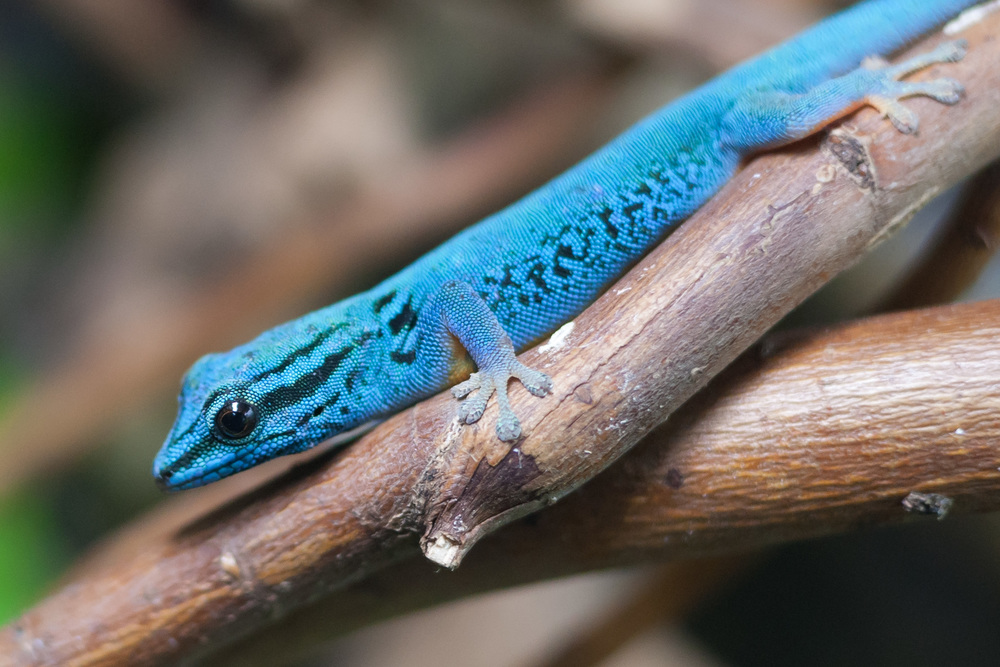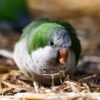- How Long Does A Quaker Parrot Live? - 17 May 2024
- 4 Hacks on Keeping Your Home Clean With Pets - 28 March 2024
- 5 Things to Know Before Bringing Home a New Kitten - 26 March 2024
Blue Crested Geckos, scientifically known as Correlophus (Rhacodactylus) ciliates, are a captivating and sought-after species within the reptile community. Their natural color is green or brown, breeders have selectively developed a range of morphs and color variations that feature stunning shades of blue.
From striped patterns to fiery gradients, a diverse array of blue morphs showcase these geckos’ beauty and versatility. Each morph possesses distinct characteristics, making them highly desirable for collectors and hobbyists. By exploring these morphs, we will explore more about the world of blue crested geckos.
Characteristics of Blue Crested Geckos

Physical Appearance
Blue Crested Geckos, scientifically known as Correlophus (Rhacodactylus) ciliatus, are known for their vibrant and captivating physical appearance. While they typically exhibit green or brown coloration in their natural state, there are specific morphs that display striking shades of blue.
Here are some details about the physical appearance of Blue Crested Geckos:
- Body Structure
With a medium-sized body structure, they usually measure between 6 to 10 inches in length, with males slightly larger than females. Their bodies are covered in small, granular scales.
- Head Characteristics
They have a relatively large head with a triangular shape. The eyes are large and round which are providing them with excellent low-light vision.
- Crest Characteristics
One of the distinctive features of Blue Crested Geckos is the crest of skin that extends from above their eyes to the base of their tail. This crest consists of rows of soft, fleshy spines or tubercles. The crest is usually laid flat against the body when the gecko is calm or at rest. However, it can raised and displayed as defensive or territorial behavior.
- Tail Characteristics
Blue Crested Geckos have a prehensile tail, which can used to grasp onto surfaces. The tail acts as a balancing tool during climbing and jumping activities.
- Coloration
It’s important to note that not all Blue Crested Geckos exhibit blue hues. Their natural color can vary, including shades of green, brown, gray, or even red. The intensity of blue can range from pale or sky blue to deeper and richer shades of blue.
- Pattern and Markings
Blue Crested Geckos can display various patterns and markings with stripes, bars, or blotches on their bodies. The patterns and markings can unique and distinct to each gecko, even within the same morph.
Facts
Certainly! Here some factual points about Blue Crested Geckos:
| Scientific Name | Correlophus (formerly Rhacodactylus) ciliatus |
| Natural Habitat | Native to New Caledonia |
| Nocturnal Behavior | They are most active at night |
| Crested Appearance | Unique crest of skin |
| Arboreal Lifestyle | spending most of their time in trees and vegetation |
| Diet | Blue Crested Geckos are omnivorous |
| Reproduction | Reproduce at around 8 to 12 months of age. Females lay eggs, typically incubated for approximately 60 to 90 days before hatching. |
| Lifespan | live for 15 to 20 years |
| Color Variation | Range of blue |
Popular Morphs of Blue Crested Geckos
- Classic Morphs
When it comes to classic morphs of Blue Crested Geckos, a few well-established and widely recognized variations have been popular among reptile enthusiasts for some time. These classic morphs may not necessarily focus on blue coloration but showcase unique patterns or traits. Here are some of the classic morphs of Blue Crested Geckos:
- Flame
The Flame morph features a vibrant red-to-orange base coloration. This morph often exhibits a gradient effect, with the color intensifying towards the head and fading towards the tail.
- Dalmatian
They exhibit spots or specks on their body. The spots can vary in size, shape, and density, creating an aesthetic appearance. They can found in various base colors, including green, brown, and even blue.
- Harlequin
The Harlequin morph is characterized by irregular scars or spots on the gecko’s body. These spots can be of various colors, including green, brown, or gray, creating a unique and intricate pattern. Harlequin morphs often exhibit high variability, making each gecko visually distinctive.
- Brindle
Brindle geckos showcase a marbled or mottled appearance on their body. The coloration may include a mixture of shades, creating a complex and intricate pattern. Brindle morphs can found in various base colors, and the pattern can vary significantly among individuals.
Unique Morphs
- Pinstripe
Pinstripe geckos have a distinct pattern of thin, vertical lines running down their bodies. These lines resemble pinstripes, hence the name. Pinstripe morphs can have different base colors, and the contrast between the stripes and the base color creates an eye-catching look.
- Quad-Stripe
The Quad-Stripe Crested Gecko is a popular morph of the Correlophus (Rhacodactylus) ciliatus species. Quad-Stripe Crested Geckos are highly sought after due to their unique and visually appealing pattern. Well-defined stripes add an extra layer of interest and attractiveness to these fascinating geckos.
Breeding and Care
Breeding Blue Crested Gecko morphs involves selectively pairing geckos with desirable blue coloration traits to produce offspring with enhanced or consistent blue colors. Here are some general steps and considerations for breeding Blue Crested Geckos:

- Acquire Blue Crested Geckos
Start with healthy and genetically diverse Blue Crested Geckos that exhibit the desired blue coloration. Look for geckos with intense and vibrant blues and any specific morphs or patterns you are interested in.
- Determine Genetic Background
Understand the genetic background of the geckos you plan to breed. This includes knowing the morphs, color variations, and inheritance patterns of blue coloration traits. This knowledge will help you make informed breeding decisions.
- Pairing Geckos
Select geckos for breeding based on their genetic makeup and desired traits. Pair geckos that carry or display desirable blue coloration traits. Consider factors such as the intensity of blue, pattern, and other morph-specific characteristics.
- Breeding Enclosure Setup
Provide a suitable breeding enclosure that meets the needs of the geckos. This includes appropriate temperature, humidity, and hiding spots. Ensure that the geckos have enough space and a comfortable environment for breeding.
- Breeding Process
Introduce the male and female geckos into the breeding enclosure. Monitor their behavior and ensure they mate successfully. Blue Crested Geckos are typically easy to breed, and the females will lay eggs that need proper incubation.
- Incubation and Hatching
Collect the eggs the female gecko lays and transfer them to an incubation medium with suitable temperature and humidity. Follow the specific requirements for Crested Gecko eggs during incubation.
Selective Breeding
Evaluate the offspring for their blue coloration traits. Select the geckos with the most desirable blue color and patterns as potential breeders for future generations. Continuously breed individuals with strong blue coloration to enhance and refine the blue morphs over time.
Conservation and Legal Considerations
Here are some essential points to consider:
Ethical Sourcing
When acquiring Blue Crested Geckos, ensure that obtained from legal and ethical sources. It’s important to support responsible breeders who prioritize the welfare and conservation of the species. Avoid purchasing geckos sourced from illegal or unsustainable practices, such as wild-caught specimens or those obtained through unethical means.
Species Conservation
Blue Crested Geckos and other reptile species may face conservation concerns in their natural habitats. Stay informed about the conservation status of the species and support efforts aimed at their conservation. This can include supporting conservation organizations, participating in captive breeding programs, and promoting habitat preservation.
Responsible Breeding Practices
Practice responsible breeding techniques to ensure the welfare and genetic diversity of Blue Crested Geckos. Avoid excessive inbreeding, which can lead to health issues and genetic problems. Maintain accurate records of your geckos’ lineage and genetic information to facilitate responsible breeding decisions.
Avoiding Hybridization
Hybridization, breeding different species or subspecies, can lead to genetic pollution and negatively impact the integrity of purebred Blue Crested Gecko populations. Be cautious to avoid accidental hybridization or intentional crossbreeding unless it is part of a carefully managed conservation program.
Education and Awareness
Promote education and awareness about Blue Crested Geckos and their conservation needs. Educate others about responsible reptile ownership, the importance of preserving their natural habitats, and the potential impacts of the pet trade on wild populations.
Crested Gecko Emotional Story on Reddit
Many people share their joys and sorrows on social media. People mostly share pictures of their pets. Similarly, a pet owner is grieving after recently losing a crested gecko. He thinks of his favorite gecko repeatedly, and he thinks about every moment he gets up or sleeps.
Conclusion
These are some of the essential aspects of Blue Crested Gecko Morphs. However, it’s important to approach the fascination with Blue Crested Gecko morphs with a sense of responsibility and respect for the species and their natural habitats. Conservation and legal considerations should always prioritized, ensuring that geckos obtained from legal and ethical sources and that breeding practices do not negatively impact wild populations or compromise the integrity of purebred lines.
















